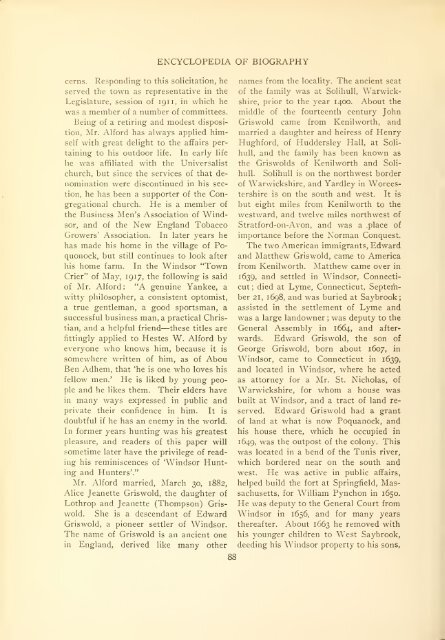Encyclopedia of Connecticut biography, genealogical-memorial ...
Encyclopedia of Connecticut biography, genealogical-memorial ...
Encyclopedia of Connecticut biography, genealogical-memorial ...
Create successful ePaper yourself
Turn your PDF publications into a flip-book with our unique Google optimized e-Paper software.
cerns. Responding to this solicitation, he<br />
served the town as representative in the<br />
Legislature, session <strong>of</strong> 191 1, in which he<br />
was a member <strong>of</strong> a number <strong>of</strong> committees.<br />
Being <strong>of</strong> a retiring and modest disposition,<br />
Mr. Alford has always applied him-<br />
self with great delight to the affairs per-<br />
taining to his outdoor life. In early life<br />
he was affiliated with the Universalist<br />
church, but since the services <strong>of</strong> that denomination<br />
were discontinued in his section,<br />
he has been a supporter <strong>of</strong> the Con-<br />
gregational church. He is a member <strong>of</strong><br />
the Business Men's Association <strong>of</strong> Windsor,<br />
and <strong>of</strong> the New England Tobacco<br />
Growers' Association. In later years he<br />
has made his home in the village <strong>of</strong> Po-<br />
quonock, but still continues to look after<br />
his home farm. In the Windsor "Town<br />
Crier" <strong>of</strong> May, 1917, the following is said<br />
<strong>of</strong> Mr. Alford : 'A genuine Yankee, a<br />
witty philosopher, a consistent optomist,<br />
a true gentleman, a good sportsman, a<br />
successful business man, a practical Chris-<br />
tian, and a helpful friend—these titles are<br />
fittingly applied to Hestes W. Alford by<br />
everyone who knows him, because it is<br />
somewhere written <strong>of</strong> him, as <strong>of</strong> Abou<br />
Ben Adhem, that 'he is one who loves his<br />
fellow men.' He is liked by young people<br />
and he likes them. Their elders have<br />
in many ways expressed in public and<br />
private their confidence in him. It is<br />
doubtful if he has an enemy in the world.<br />
In former years hunting was his greatest<br />
pleasure, and readers <strong>of</strong> this paper will<br />
sometime later have the privilege <strong>of</strong> reading<br />
his reminiscences <strong>of</strong> 'Windsor Hunting<br />
and Hunters'."<br />
Mr. Alford married, March 30, 1882,<br />
Alice Jeanette Griswold, the daughter <strong>of</strong><br />
Lothrop and Jeanette (Thompson) Griswold.<br />
She is a descendant <strong>of</strong> Edward<br />
Griswold, a pioneer settler <strong>of</strong> Windsor.<br />
The name <strong>of</strong> Griswold is an ancient one<br />
in England, derived like many other<br />
ENCYCLOPEDIA OF BIOGRAPHY<br />
88<br />
names from the locality. The ancient seat<br />
<strong>of</strong> the family was at Solihull, Warwick-<br />
shire, prior to the year 1400. About the<br />
middle <strong>of</strong> the fourteenth century John<br />
Griswold came from Kenilworth, and<br />
married a daughter and heiress <strong>of</strong> Henry<br />
Hughford, <strong>of</strong> Huddersley Hall, at Soli-<br />
hull, and the family has been known as<br />
the Griswolds <strong>of</strong> Kenilworth and Soli-<br />
hull. Solihull is on the northwest border<br />
<strong>of</strong> Warwickshire, and Yardley in Worces-<br />
tershire is on the south and west. It is<br />
but eight miles from Kenilworth to the<br />
westward, and twelve miles northwest <strong>of</strong><br />
Stratford-on-Avon, and was a place <strong>of</strong><br />
importance before the Xorman Conquest.<br />
The two American immigrants, Edward<br />
and Matthew Griswold, came to America<br />
from Kenilworth. Matthew came over in<br />
1639, and settled in Windsor, <strong>Connecticut</strong><br />
; died at Lyme, <strong>Connecticut</strong>, September<br />
21, 1698, and was buried at Saybrook;<br />
assisted in the settlement <strong>of</strong> Lyme and<br />
was a large landowner ; was deputy to the<br />
General Assembly in 1664, and after-<br />
wards. Edward Griswold, the son <strong>of</strong><br />
George Griswold, born about 1607, in<br />
Windsor, came to <strong>Connecticut</strong> in 1639,<br />
and located in Windsor, where he acted<br />
as attorney for a Mr. St. Nicholas, <strong>of</strong><br />
Warwickshire, for whom a house was<br />
built at Windsor, and a tract <strong>of</strong> land re-<br />
served. Edward Griswold had a grant<br />
<strong>of</strong> land at what is now Poquanock, and<br />
his house there, which he occupied in<br />
1649, was tne outpost <strong>of</strong> the colony. This<br />
was located in a bend <strong>of</strong> the Tunis river,<br />
which bordered near on the south and<br />
west. He was active in public affairs,<br />
helped build the fort at Springfield, Mas-<br />
sachusetts, for William Pynchon in 1650.<br />
He was deputy to the General Court from<br />
Windsor in 1656, and for many years<br />
thereafter. About 1663 he removed with<br />
his younger children to West Saybrook,<br />
deeding his Windsor property to his sons,

















